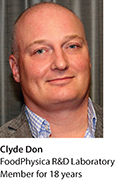 Q: What is your current position and what type of work do you do?
Q: What is your current position and what type of work do you do?
A: I am the owner/director of Clyde Don Consultancy a sole proprietorship and director of the FoodPhysica R&D Laboratory in the Netherlands. My laboratory is a multidisciplinary contract research lab—we support the R&D of several clients, from start-ups in food and agribusiness to multinationals. Around 80% of our contract research is related to foods and beverages, currently with growth in research projects on plant proteins, sustainable proteins, and circular economy. About 20% of our business is related to nonfood research, which falls under ChemPhysica, a branch of our R&D lab that supports clients in upcycling waste streams, compostable packaging materials, and green chemistry.
Q: When and how did you first decide you wanted to work in cereal grain science?
A: To be honest, it was not really a decision. In 1997 I started at TNO (some readers may still remember the former TNO Cereals Institute). Initially, I had no clue about TNO’s tradition in cereals. My first job was in the Protein & Meat Technology Department. After working on industrial proteins, other ingredients were integrated into my projects because around 2000 our strategy was focused on novel foods, healthier foods, protein allergens, edible coatings, and future product formulating. Gluten became part of my scope in a project to expand the application of gluten proteins. Concurrently, a TNO fund on gluten proteins became available. The fund was for a project with scientific merit; publishing papers and delivering a doctoral thesis were the targets. My manager at the time, Martin Hessing, saw fit to allocate this special fund to me, Prof. Rob Hamer was the doctoral advisor, and the rest is history.
Q: How have you been involved with AACCI? How has your involvement with AACCI enriched your career?
A: With the “gluten project” in place, it was suggested that I become an AACCI member. The early years of my membership were focused on presenting, publishing, and discussing scientific findings with my peers. The constructive conversations with experts in the field, such as the late Jerry Bietz, were most helpful. Scientific collaborations with George Lookhart, Finlay MacRitchie, Phil Williams, and Ferenc Bekes all started at AACCI Annual Meetings. Later on, I took on several leadership roles in AACCI Divisions and as Annual Meeting Track Chair and Chair of the Protein Technical Committee. Currently, I am part of the CFW guest editors team. In short, AACCI enriched me in science, networking, leadership, organizational skills, peer review, and editing.
Q: What types of future innovation do you see in the field of cereal science? How are broader societal and technology trends affecting cereal science and the cereal grain industry overall?
A: Cereals and grain-based foods will always be dominant in a healthy human diet. The topics mentioned at Q2 are still important today. “Future product formulation” is a key phrase directing product innovations such as low salt, low sugar, low FODMAP, more fiber, free from, gluten-free, natural ingredients, etc., etc. At the same time, future formulation addresses human health, sustainability, quality, and consumer acceptance. With a growing population and a continuing trend toward eating less meat, we need the grain industry to provide nutritious food products. Society is concerned about health, authenticity, safety, and sustainability. Cereal scientists are seeking innovative solutions to address these concerns, using multidisciplinary approaches and connecting the innovation chain from seed to food.
Q: This issue of Cereal Foods World focuses on innovation through the value chain. Do you have any perspectives on this topic?
A: Cereal scientists are well adapted to face future challenges in the food innovation chain. Including the value chain is a prerequisite for motivating industrial partners to invest in private and public research programs. Public–private initiatives especially, such as in the Netherlands, have proven to be a powerhouse for delivering food innovation throughout the value chain, showing that fruitful and impactful collaboration among industry, private/institutional labs, and academia is the way forward.
Q: What’s next for you?
A: Next year will be the 10th anniversary of FoodPhysica. A plan for a festive symposium is in the making. We are also celebrating ongoing laboratory expansion plans to deliver more contract R&D services to our clients. Answering the questions in this member spotlight made me realize how time has flown past. Over the previous 10 years, my research activities have diversified into areas other than cereal science, and this will probably continue over the next 10 years. Nonetheless, AACCI has played a role in enlarging my network and improving my skills to become a successful consultant, independent scientist, and lab owner.
